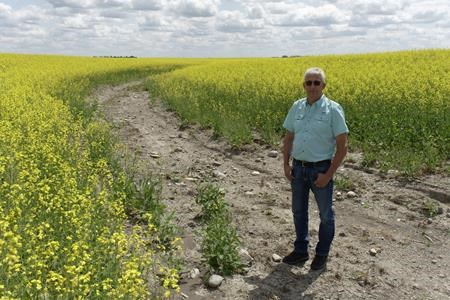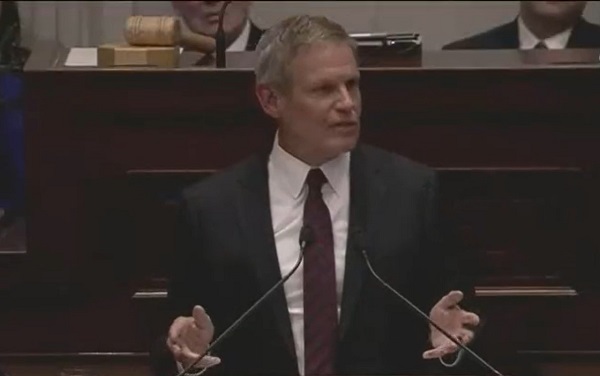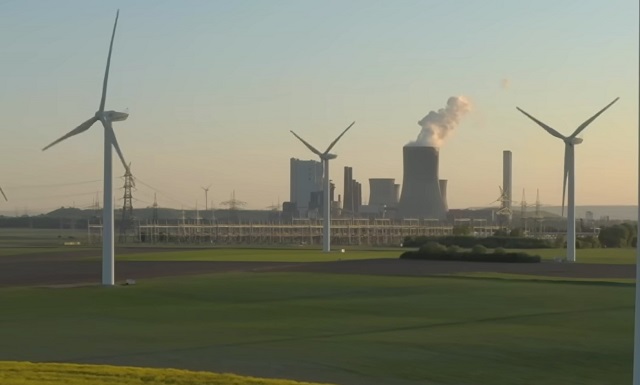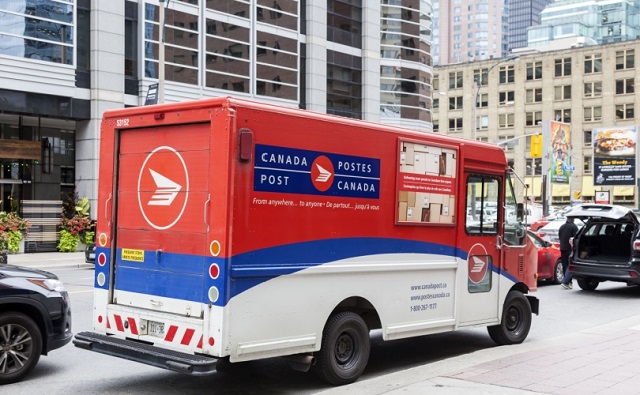Alberta
‘Not as dramatic’: Saskatchewan farmers draining water demonstrate benefits

GRENFELL, Sask. — It’s an area of farmland Ryan Maurer says is worth as much as a Lamborghini.
High run-off flooded one of his fields in spring 2022, leaving shallow pools of water. This was before the farmer opened ditches to drain it.
“Would you take your Lamborghini and park it in a slough?” Maurer asked on his farm near Grenfell, Sask., about 125 kilometres east of Regina.
No, he says, he wouldn’t.
“But society’s asking us to do that,” Maurer added. “And then they turn around and tell us to grow more food.”
Maurer’s land is part of a drainage network known as the Tetlock Conservation and Development Area Authority. It’s where farmers work together to move water through each other’s land and out into a creek.
The farmers in the Tetlock network say the water is moved in a managed and slower pace when it’s released, helping mitigate potential flooding downstream. There are control gates, smaller culverts, tile piping and holding ponds.
In fact, the Tetlock normally only adds 0.5 per cent of water to the flow of the creek, indicates data provided by the farmers who oversee the network.
“It’s not as dramatic as everybody says it is,” said Owen Pekrul, a farmer who’s also part of the drainage network. “Because it’s a ditch or it’s organized, they think it affects a lot of things.”
But for some, drainage is a problem.
Farmers downstream of some other networks say huge gushes of water continue to wash out their fields each year.
Environmental groups also worry about the loss of wetlands, as some are drained to make way for more arable acres. They say this puts habitats at risk and causes water quality to degrade.
Rural municipalities have raised concerns about illegal works causing water to breach grid roads.
Rural officials have asked the Water Security Agency, which is in charge of overseeing drainage, to ensure illegal drainers get permits.
“The biggest concern that we have is that many ratepayers just are not following the rules that are in place, the laws if you will,” said Helen Meekins, a councillor with the Rural Municipality of Pleasantdale in southeast Saskatchewan.
“The rural municipality isn’t against drainage,” Meekins added. “But, if they go through the permit process, then at least we know where there’s going to be more water and how it’s going to affect the infrastructure that we have in place.”
Some farmers say managed networks, such as the Tetlock, could help address flooding issues as long as everyone upstream and downstream can work together.
Maurer, as well as others involved in the network, are members of the Saskatchewan Farm Stewardship Association, a group that has lobbied the province for managed drainage to promote soil health and crop production.
He said drainage helps him turn soil that’s too salty into something that can grow healthy crops.
It also allows him to be more productive with his time on the field. That’s because those working the machines don’t have to move around various sloughs when they apply fertilizer and spray chemicals.
“These little sloughs are a couple inches of water. There’s nothing major,” Maurer said. “So, we over-apply. How do we get around that? Well, drainage and management is the answer.”
Not all drainage has been done in a managed way in Saskatchewan.
For decades, producers have dug ditches to move water out without approval from the Water Security Agency.
In 2018, Saskatchewan’s auditor estimated there were up to 9,712 square kilometres of land with unapproved works.
The agency has said it’s brought many unpermitted works into compliance by working with landowners and making sure the stream, pond or lake can handle the amount of water flowing in.
Research projects have also been looking into best practices. In one, a farmer has been draining water from various sloughs into one larger consolidation pond.
Candace Mitschke, the executive director with the Saskatchewan Farm Stewardship Association, said different solutions are required for each farm because landscapes across the province aren’t the same.
But, she said, issues can be resolved when people work together.
In rare cases, farmers have expropriated downstream land so they can get a permit and manage the water appropriately.
“Sometimes you’re not going to get people to co-operate no matter what you do. In those cases, that’s when expropriation is that important piece and enables that network to function,” Mitschke said.
The Water Security Agency still has a ways to go to bring all unapproved works into compliance.
Since 2017, only about a third of land with unpermitted works, about 3,146 square kilometres, has been brought into compliance.
Saskatchewan’s auditor has recommended unpermitted drainage be addressed quickly. The longer people wait, it noted, the more frustrated they become.
The auditor has also recommended the agency establish a wetlands policy to ensure water quality doesn’t degrade, which the agency says it’s working on.
For Maurer, it’s all about water management. He again pointed to the Tetlock network as an example of good practices.
“If everybody did that, it would be managed going in,” he said. “Just by saying, ‘Quit draining water,’ it doesn’t help anybody. It creates the problem.”
This report by The Canadian Press was first published July 22, 2023.
Jeremy Simes, The Canadian Press
Alberta
Game changer: Trans Mountain pipeline expansion complete and starting to flow Canada’s oil to the world

Workers complete the “golden weld” of the Trans Mountain pipeline expansion on April 11, 2024 in the Fraser Valley between Hope and Chilliwack, B.C. The project saw mechanical completion on April 30, 2024. Photo courtesy Trans Mountain Corporation
From the Canadian Energy Centre
By Will Gibson
‘We’re going to be moving into a market where buyers are going to be competing to buy Canadian oil’
It is a game changer for Canada that will have ripple effects around the world.
The Trans Mountain pipeline expansion is now complete. And for the first time, global customers can access large volumes of Canadian oil, with the benefits flowing to Canada’s economy and Indigenous communities.
“We’re going to be moving into a market where buyers are going to be competing to buy Canadian oil,” BMO Capital Markets director Randy Ollenberger said recently, adding this is expected to result in a better price for Canadian oil relative to other global benchmarks.
The long-awaited expansion nearly triples capacity on the Trans Mountain system from Edmonton to the West Coast to approximately 890,000 barrels per day. Customers for the first shipments include refiners in China, California and India, according to media reports.
Shippers include all six members of the Pathways Alliance, a group of companies representing 95 per cent of oil sands production that together plan to reduce emissions from operations by 22 megatonnes by 2030 on the way to net zero by 2050.
The first tanker shipment from Trans Mountain’s expanded Westridge Marine Terminal is expected later in May.
 Photo courtesy Trans Mountain Corporation
Photo courtesy Trans Mountain Corporation
The new capacity on the Trans Mountain system comes as demand for Canadian oil from markets outside the United States is on the rise.
According to the Canada Energy Regulator, exports to destinations beyond the U.S. have averaged a record 267,000 barrels per day so far this year, up from about 130,000 barrels per day in 2020 and 33,000 barrels per day in 2017.
“Oil demand globally continues to go up,” said Phil Skolnick, New York-based oil market analyst with Eight Capital.
“Both India and China are looking to add millions of barrels a day of refining capacity through 2030.”
In India, refining demand will increase mainly for so-called medium and heavy oil like what is produced in Canada, he said.
“That’s where TMX is the opportunity for Canada, because that’s the route to get to India.”
Led by India and China, oil demand in the Asia-Pacific region is projected to increase from 36 million barrels per day in 2022 to 52 million barrels per day in 2050, according to the U.S. Energy Information Administration.
More oil coming from Canada will shake up markets for similar world oil streams including from Russia, Ecuador, and Iraq, according to analysts with Rystad Energy and Argus Media.
Expanded exports are expected to improve pricing for Canadian heavy oil, which “have been depressed for many years” in part due to pipeline shortages, according to TD Economics.
 Photo courtesy Trans Mountain Corporation
Photo courtesy Trans Mountain Corporation
In recent years, the price for oil benchmark Western Canadian Select (WCS) has hovered between $18-$20 lower than West Texas Intermediate (WTI) “to reflect these hurdles,” analyst Marc Ercolao wrote in March.
“That spread should narrow as a result of the Trans Mountain completion,” he wrote.
“Looking forward, WCS prices could conservatively close the spread by $3–4/barrel later this year, which will incentivize production and support industry profitability.”
Canada’s Parliamentary Budget Office has said that an increase of US$5 per barrel for Canadian heavy oil would add $6 billion to Canada’s economy over the course of one year.
The Trans Mountain Expansion will leave a lasting economic legacy, according to an impact assessment conducted by Ernst & Young in March 2023.
In addition to $4.9 billion in contracts with Indigenous businesses during construction, the project leaves behind more than $650 million in benefit agreements and $1.2 billion in skills training with Indigenous communities.
Ernst & Young found that between 2024 and 2043, the expanded Trans Mountain system will pay $3.7 billion in wages, generate $9.2 billion in GDP, and pay $2.8 billion in government taxes.
Alberta
Alberta government should eliminate corporate welfare to generate benefits for Albertans

From the Fraser Institute
By Spencer Gudewill and Tegan Hill
Last November, Premier Danielle Smith announced that her government will give up to $1.8 billion in subsidies to Dow Chemicals, which plans to expand a petrochemical project northeast of Edmonton. In other words, $1.8 billion in corporate welfare.
And this is just one example of corporate welfare paid for by Albertans.
According to a recent study published by the Fraser Institute, from 2007 to 2021, the latest year of available data, the Alberta government spent $31.0 billion (inflation-adjusted) on subsidies (a.k.a. corporate welfare) to select firms and businesses, purportedly to help Albertans. And this number excludes other forms of government handouts such as loan guarantees, direct investment and regulatory or tax privileges for particular firms and industries. So the total cost of corporate welfare in Alberta is likely much higher.
Why should Albertans care?
First off, there’s little evidence that corporate welfare generates widespread economic growth or jobs. In fact, evidence suggests the contrary—that subsidies result in a net loss to the economy by shifting resources to less productive sectors or locations (what economists call the “substitution effect”) and/or by keeping businesses alive that are otherwise economically unviable (i.e. “zombie companies”). This misallocation of resources leads to a less efficient, less productive and less prosperous Alberta.
And there are other costs to corporate welfare.
For example, between 2007 and 2019 (the latest year of pre-COVID data), every year on average the Alberta government spent 35 cents (out of every dollar of business income tax revenue it collected) on corporate welfare. Given that workers bear the burden of more than half of any business income tax indirectly through lower wages, if the government reduced business income taxes rather than spend money on corporate welfare, workers could benefit.
Moreover, Premier Smith failed in last month’s provincial budget to provide promised personal income tax relief and create a lower tax bracket for incomes below $60,000 to provide $760 in annual savings for Albertans (on average). But in 2019, after adjusting for inflation, the Alberta government spent $2.4 billion on corporate welfare—equivalent to $1,034 per tax filer. Clearly, instead of subsidizing select businesses, the Smith government could have kept its promise to lower personal income taxes.
Finally, there’s the Heritage Fund, which the Alberta government created almost 50 years ago to save a share of the province’s resource wealth for the future.
In her 2024 budget, Premier Smith earmarked $2.0 billion for the Heritage Fund this fiscal year—almost the exact amount spent on corporate welfare each year (on average) between 2007 and 2019. Put another way, the Alberta government could save twice as much in the Heritage Fund in 2024/25 if it ended corporate welfare, which would help Premier Smith keep her promise to build up the Heritage Fund to between $250 billion and $400 billion by 2050.
By eliminating corporate welfare, the Smith government can create fiscal room to reduce personal and business income taxes, or save more in the Heritage Fund. Any of these options will benefit Albertans far more than wasteful billion-dollar subsidies to favoured firms.
Authors:
-

 conflict1 day ago
conflict1 day agoOver 200 Days Into War, Family Of American Hostage in Gaza Strives For Deal To Bring Son Home
-

 Economy2 days ago
Economy2 days ago‘Gambling With The Grid’: New Data Highlights Achilles’ Heel Of One Of Biden’s Favorite Green Power Sources
-

 Brownstone Institute24 hours ago
Brownstone Institute24 hours agoBook Burning Goes Digital
-

 Brownstone Institute13 hours ago
Brownstone Institute13 hours agoThe Predictable Wastes of Covid Relief
-

 ESG2 days ago
ESG2 days agoTennessee Taking Lead In Protecting Civil Rights And Free Enterprise—And Stopping Political Debanking
-

 Energy2 days ago
Energy2 days agoMarket Realities Are Throwing Wrench In Biden’s Green Energy Dreams
-

 Alberta4 hours ago
Alberta4 hours agoGame changer: Trans Mountain pipeline expansion complete and starting to flow Canada’s oil to the world
-

 Addictions4 hours ago
Addictions4 hours agoCanada’s ‘safer supply’ patients are receiving staggering amounts of narcotics









